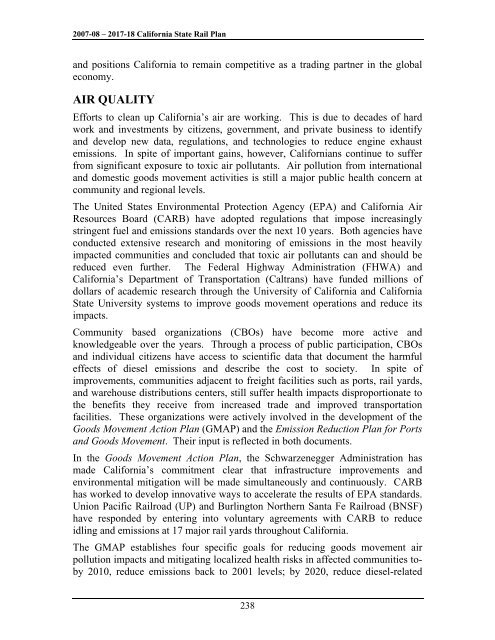California State Rail Plan 2007-08 to 2017-18
California State Rail Plan 2007-08 to 2017-18
California State Rail Plan 2007-08 to 2017-18
- No tags were found...
You also want an ePaper? Increase the reach of your titles
YUMPU automatically turns print PDFs into web optimized ePapers that Google loves.
<strong>2007</strong>-<strong>08</strong> – <strong>2017</strong>-<strong>18</strong> <strong>California</strong> <strong>State</strong> <strong>Rail</strong> <strong>Plan</strong>and positions <strong>California</strong> <strong>to</strong> remain competitive as a trading partner in the globaleconomy.AIR QUALITYEfforts <strong>to</strong> clean up <strong>California</strong>’s air are working. This is due <strong>to</strong> decades of hardwork and investments by citizens, government, and private business <strong>to</strong> identifyand develop new data, regulations, and technologies <strong>to</strong> reduce engine exhaustemissions. In spite of important gains, however, <strong>California</strong>ns continue <strong>to</strong> sufferfrom significant exposure <strong>to</strong> <strong>to</strong>xic air pollutants. Air pollution from internationaland domestic goods movement activities is still a major public health concern atcommunity and regional levels.The United <strong>State</strong>s Environmental Protection Agency (EPA) and <strong>California</strong> AirResources Board (CARB) have adopted regulations that impose increasinglystringent fuel and emissions standards over the next 10 years. Both agencies haveconducted extensive research and moni<strong>to</strong>ring of emissions in the most heavilyimpacted communities and concluded that <strong>to</strong>xic air pollutants can and should bereduced even further. The Federal Highway Administration (FHWA) and<strong>California</strong>’s Department of Transportation (Caltrans) have funded millions ofdollars of academic research through the University of <strong>California</strong> and <strong>California</strong><strong>State</strong> University systems <strong>to</strong> improve goods movement operations and reduce itsimpacts.Community based organizations (CBOs) have become more active andknowledgeable over the years. Through a process of public participation, CBOsand individual citizens have access <strong>to</strong> scientific data that document the harmfuleffects of diesel emissions and describe the cost <strong>to</strong> society. In spite ofimprovements, communities adjacent <strong>to</strong> freight facilities such as ports, rail yards,and warehouse distributions centers, still suffer health impacts disproportionate <strong>to</strong>the benefits they receive from increased trade and improved transportationfacilities. These organizations were actively involved in the development of theGoods Movement Action <strong>Plan</strong> (GMAP) and the Emission Reduction <strong>Plan</strong> for Portsand Goods Movement. Their input is reflected in both documents.In the Goods Movement Action <strong>Plan</strong>, the Schwarzenegger Administration hasmade <strong>California</strong>’s commitment clear that infrastructure improvements andenvironmental mitigation will be made simultaneously and continuously. CARBhas worked <strong>to</strong> develop innovative ways <strong>to</strong> accelerate the results of EPA standards.Union Pacific <strong>Rail</strong>road (UP) and Burling<strong>to</strong>n Northern Santa Fe <strong>Rail</strong>road (BNSF)have responded by entering in<strong>to</strong> voluntary agreements with CARB <strong>to</strong> reduceidling and emissions at 17 major rail yards throughout <strong>California</strong>.The GMAP establishes four specific goals for reducing goods movement airpollution impacts and mitigating localized health risks in affected communities <strong>to</strong>by2010, reduce emissions back <strong>to</strong> 2001 levels; by 2020, reduce diesel-related238













